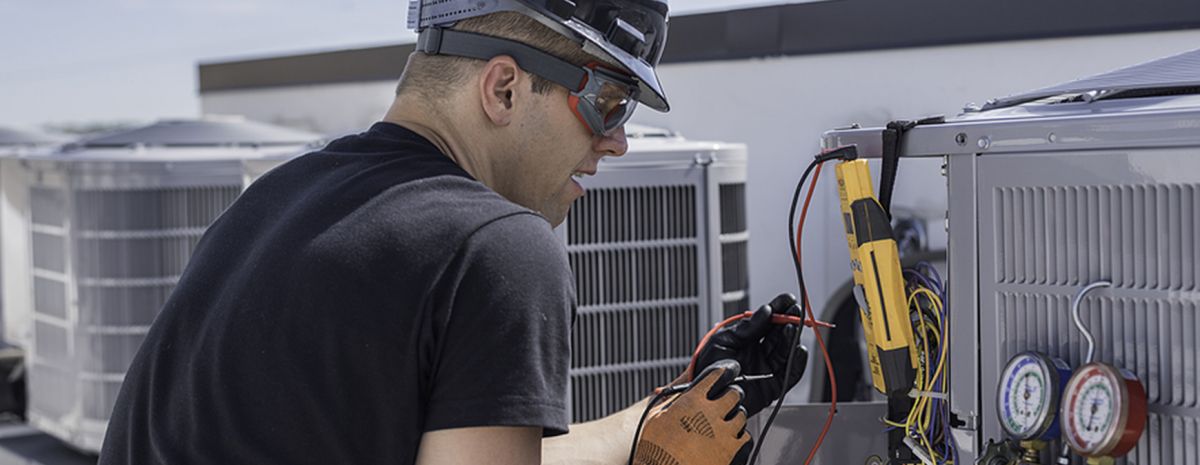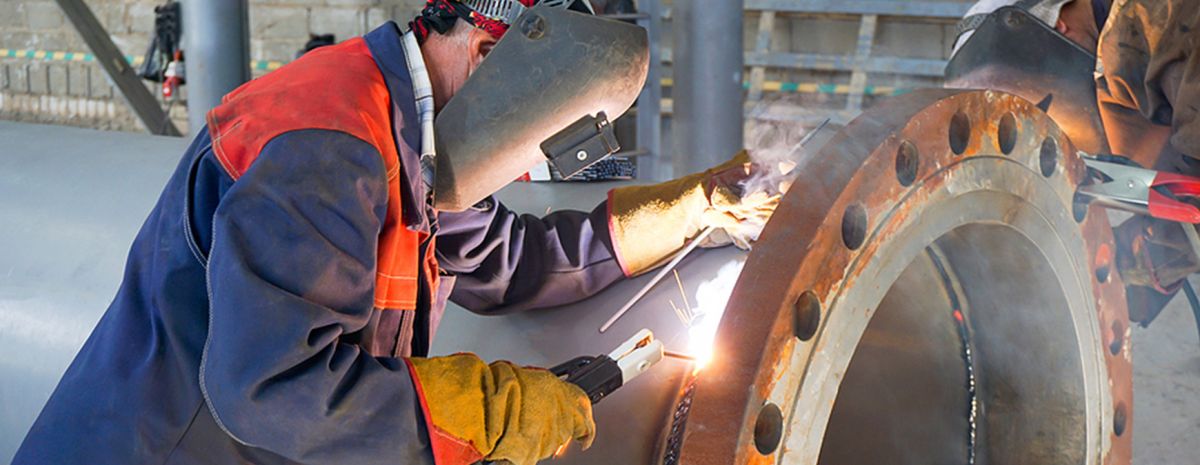
Analysts anticipate 2.4 million manufacturing jobs in the U.S. to go unfilled over the next 8 years, negatively impacting the country’s economy to the tune of $454 billion.1 This could mean blue-collar job opportunities in this sector.
And manufacturing likely won’t be the only industry with job growth. In fact, blue-collar career prospects could be good in the skilled trades because many are projected to grow at or faster than the average job growth through 2029:2,3,4
- HVAC Technician: 4% job growth2*
- Pipefitter: 4% job growth3**
- Electrician: 8% job growth4
See why these 3 skilled trades could be considered some of the best blue-collar careers in 2021.
What’s a Blue-Collar Career?
What’s a blue-collar career? A blue-collar career is typically a career that doesn’t require a college education. Instead, workers can prepare for blue-collar careers in vocational training programs.5
Work settings can also set blue-collar careers apart from their white-collar counterparts: for one, you probably won’t spend much time in an office. Instead of a suit and tie, you’ll probably wear a hard hat and toolbelt. And you can forget about sitting all day; these jobs can be physically demanding.5
Have You Considered a Career in the Skilled Trades?
Fill out the form to recieve a no obligation info packet.
3 of the Best Blue-Collar Careers for 2021
What makes a particular line of work one of the best blue-collar careers? Job growth can be one factor because it could mean more open positions. Pay can be another consideration. Do entry-level positions in the field offer livable (or better) wages?5
Check out how the numbers stack up for the 3 skilled trades careers below.
1. HVAC Technician

Job Growth
An HVAC Technician installs, maintains and repairs heating, cooling, air conditioning and refrigeration equipment. The need for HVAC professionals is expected to grow 4% through 2029, which is as fast as average.2*
Training Requirements
Depending on whether you seek a certificate of associate degree, you can train for entry level positions in six months to two years. It’s common for HVAC technicians to have postsecondary training. In fact, many employers prefer this credential because HVAC systems have been increasing in complexity.6
Pay
The median income for this occupation was $50,590 in 2020, reports the U.S. Bureau of Labor Statistics. The median represents the point at which half of workers make more and half make less.2 It’s not uncommon for blue-collar jobs to come with benefits.7***
Duties and Work Settings
If you would like to travel around town, working on various residential or commercial projects, installing units, working independently or with a team of people, and troubleshooting customer problems, then you might find job satisfaction as an HVAC technician.2,8
An HVAC tech should be prepared to potentially work in hot or cold conditions or in inclement weather from time to time. Depending on your role, you may also get to work outside on the nice days, when people in other jobs are stuck inside.2
2. Pipefitter

Job Growth
As a pipefitter, your primary job could be to the install and repair piping. This career path is projected to grow at a rate of 4% through 2029, which is as fast as average.3**
Pay
The median salary for pipefitters was $55,160 a year in 2019. That’s $26.52 per hour.3****
Training Requirements
Some people choose an apprenticeship to learn the pipefitter trade. Others opt for a combination of pipe fitter training at a trade school and on-the-job training.3
Duties and Work Settings
Pipefitters spend their days working in businesses and factories, installing and maintaining pipes. These pipes may carry acids, gases and chemicals. “Fitters,” as they’re often called, may work in power plants or large office buildings, where they’re tasked with maintaining the pipework for heating and cooling systems.9
Pipefitting can require knowledge of pneumatic (air) and hydraulic (water) pressure, as well as electronic controls, making it a potentially satisfying job for someone interested in the practical application of physics and mechanics. Welding (MIG, TIG, SMAW), soldering and plasma cutting can also be important pipefitter skills.10
3. Electrician

Job Growth
An electrician usually installs, tests and maintains electrical systems. Jobs in this field are expected to be added at a rate of 8% through 2029, making this an industry that’s growing much faster than average.4
Pay
The median pay for electricians in 2019 was $56,180. This is $27.01 per hour.4*****
Training Requirements
Some workers learn the basics of electricity in an electrician training program at a trade school, and many go on to continue their career preparation in an apprenticeship.4
Duties and Work Settings
Most electricians work full-time, and many work weekends. It’s not uncommon to work overtime.4
Electricians surveyed by U.S. News and World Report said that variety is one of the best things about this career. They don’t get bored. Electricians often need to solve problems and continually learn new things on the job. Electricians may work indoors and out, moving from project to project, so they usually stay active.11
Train for a Blue-Collar Career in the Skilled Trades
Are you thinking one of these skilled trades careers could be a good fit for you? Completing a training program can be a first step on the path to entry level positions in these fields.2,3,4
Chat with a Tulsa Welding School admissions team member today. Call 855-806-4921.
Additional Sources
* According to BLS data Florida employed 31,710 Heating, Air Conditioning, and Refrigeration Mechanics and Installers
(499021) and Texas employed 26,690 Heating, Air Conditioning, and Refrigeration Mechanics and Installers (499021)
through May 2019: BLS
**According to BLS data Oklahoma employed 11,390 Welders, Cutters, Solderers, and Brazers (514121), Florida employed
13,730 Welders, Cutters, Solderers, and Brazers (514121) and Texas employed 50,790 Welders, Cutters, Solderers, and
Brazers (514121) through May 2019: BLS
*** Average starting salary for Electro-Mechanical Technologies is $28,981 for TWS graduates employed during the 12
month period of 7/1/18 – 6/30/19. Average starting salary for Refrigeration Technologies is $26,637 for TWS Jacksonville
graduates and $32,500 for TWSTC graduates employed during the 12 month period of 7/1/18 – 6/30/19. According to BLS data
May 2019, Heating, Air Conditioning, and Refrigeration Mechanics and Installers (499021) annual mean wage is $46,760 for the Jacksonville area and $46,840 for the Houston area: BLS.
**** Average starting salary for Professional Welder with Pipefitting is $31,275 for TWS graduates and $36,374 for TWS Jacksonville graduates employed during the 12 month period of 7/1/18 – 6/30/19. Average starting salary for Welding Specialist with Pipefitting is $34,912 for TWSTC graduates employed during the 12 month period of 7/1/18 – 6/30/19.
***** Average starting salary for Electrical Applications is $28,296 for TWS graduates employed during the 12 month
period of 7/1/18 – 6/30/19.
1https://www2.deloitte.com/us/en/pages/about-deloitte/articles/2018-manufacturing-skills-gap-study.html
2https://www.bls.gov/OOH/installation-maintenance-and-repair/heating-air-conditioning-and-refrigeration-mechanics-and-installers.htm
3https://www.bls.gov/OOH/construction-and-extraction/plumbers-pipefitters-and-steamfitters.htm
4https://www.bls.gov/OOH/construction-and-extraction/electricians.htm
5https://www.careertoolbelt.com/best-blue-collar-jobs/
6https://www.bls.gov/OOH/installation-maintenance-and-repair/heating-air-conditioning-and-refrigeration-mechanics-and-installers.htm#tab-4
7https://www.shrm.org/hr-today/news/all-things-work/pages/the-blue-collar-drought.aspx
8https://www.bls.gov/OOH/installation-maintenance-and-repair/heating-air-conditioning-and-refrigeration-mechanics-and-installers.htm#tab-2
9https://www.bls.gov/OOH/construction-and-extraction/plumbers-pipefitters-and-steamfitters.htm#tab-2
10https://www.pftc533.com/index.cfm?zone=/unionactive/view_page.cfm&page=new20What20is20a20Pipefitter3F
11https://money.usnews.com/careers/best-jobs/electrician/reviews
This blog has been labeled as archived as it may no longer contain the most up-to-date data. For a list of all current blog posts, please visit our blog homepage at https://www.tws.edu/blog/




